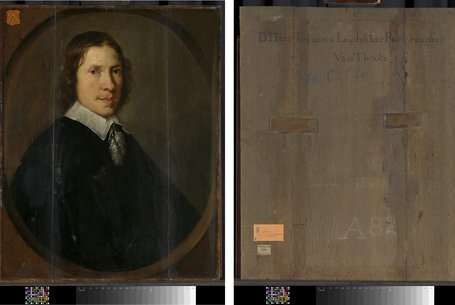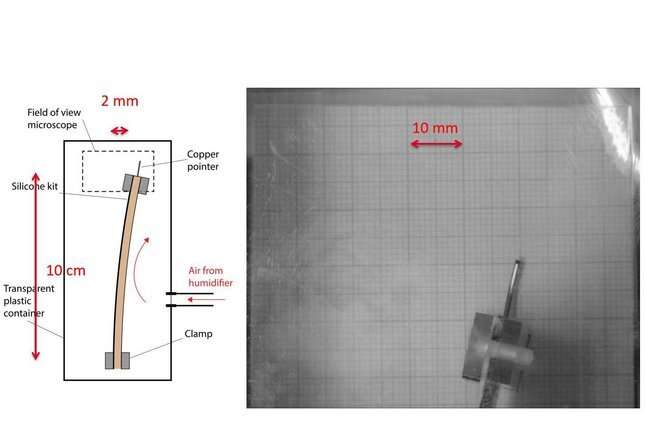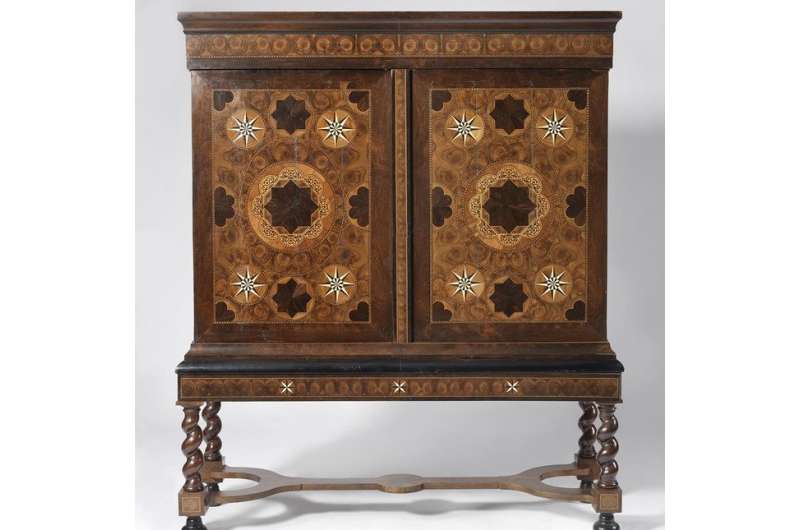Bernardus Swaerdecroon, 1646. Damage is visible in the vertical direction, where the three wooden panels are attached to one another. (Rijksmuseum inv. no. SK-A-828).
Large museums have climate systems to protect their objects from bending or cracking. These systems are set up for limited fluctuations in humidity, based on the assumption that larger variations are harmful. This assumption, however, has never been scientifically substantiated. The Rijksmuseum and the Cultural Heritage Agency therefore asked the technical universities to investigate this. Research by TU/e Ph.D. students Thomas Arends and Rianne Luimes has now indicated that greater fluctuations are acceptable. This could save a lot of energy and CO2. Arends and Luimes will obtain their doctorates at Eindhoven University of Technology on 12 and 17 September respectively.
Moisture presents a great danger to museum objects. Wood is particularly sensitive to this: even minimal moisture fluctuations cause the material to expand and contract repeatedly. If the internal forces become excessive, there is even a risk of cracking. Museum objects that suffer from this include, for example, oak panel paintings from before the 17th century or the doors of 17th century furniture such as cabinets.
In the case of panel paintings, any damage is often the result of differences in moisture permeability. The layers of paint on the front of the panel only allow moisture to slowly pass through. As a result, most of the moisture exchange occurs at the back of the panel. This uneven distribution of moisture causes the panel to bend. If the internal tension becomes too great, the paint layer or even the wood may crack. In the case of cabinet doors, the fiber orientation of the boards is the most critical factor. If the boards are glued together in different directions, the influence of moisture may cause one board to expand or contract more than the other. This creates tensile stress, which can eventually lead to cracks.
Experimental set-up of Thomas Arends. An oak board (coated on one side) was fastened in a small climate chamber with adjustable humidity. The needle at the top then showed the degree of bending while the humidity was increased from 50 percent to 90 percent in a matter of seconds. Credit: Eindhoven University of Technology
Constant humidity
In order to prevent such damage, museums have strict climate systems that keep humidity constant. The maximum humidity fluctuation of these systems is often set at ten percent (plus or minus 5 %). Arends: "That figure is based more on fear than on science. How far panels bend in response to certain fluctuations in humidity has never been unequivocally investigated."
Luimes and Arends were therefore asked by the Rijksmuseum and the Cultural Heritage Agency to scientifically determine the maximum acceptable fluctuation. They both looked at moisture transport in oak museum objects. Luimes focused on cabinet doors, while Arends investigated panel paintings. Each Ph.D. student, however, did their research at a separate department, so their starting points were very different. However, they both reached the same conclusion: the permitted moisture fluctuation of ten percent appears to be too strict. This outcome could save museums a lot of energy. The Rijksmuseum has stated that it attaches great importance to sustainability, as long as the climate is safe for the art objects that have been entrusted to their care.
17th century oak cabinet. Damage is visible in the vertical direction on both doors, where the three wooden panels are attached to one another. (Rijksmuseum inv. no. BK-NM-6073). Credit: Eindhoven University of Technology
Twenty percent moisture fluctuation seems feasible
Arends, who will obtain a doctorate in Applied Physics and Mechanical Engineering, looked at moisture transport through wood from a physical point of view. His research seems to indicate that a fluctuation of twenty percent (plus or minus 10 %) should also be acceptable. "However, this data still needs to be verified experimentally in order to be applicable in new museum guidelines in the future," says Arends. For his Ph.D., he developed a mathematical model that can predict the bending of panel paintings for every fluctuation in humidity, thickness of wood and thickness of paint layers. To test his model, Arends even examined a real door from 1885, originating from the Rijksmuseum building, in an MRI scanner. "The speed of the moisture fluctuations appears to be particularly decisive when it comes to bending. Thin panels are the most vulnerable," explains Arends.
Old wood is less strong
Luimes, who will obtain a doctorate from the Department of the Built Environment, looked at mechanical forces on wood. Her results show that older wood is not as strong as new wood. "A wooden cabinet door will age over a period of several centuries and therefore slowly becomes less resistant to fluctuations in humidity," says Luimes. She submitted 13th, 17th and 21st century pieces of wood to a so-called fracture test, in which the force on the wood is increased until it breaks. Luimes then validated the findings using computer simulations. Her computer model can predict, based on the way that the boards are glued together and how old the wood is, whether a cabinet door is at risk of damage at a certain permitted moisture fluctuation. "For many 17th century cabinets, the climate system could be less strict, but it is important to determine this limit separately for each object," concludes Luimes.
More information: Thesis: dynamic moisture-induced bending of oak boards. pure.tue.nl/ws/files/133338008/20190912_Arends.pdf
Thesis: climate-induced damage in oak museum: objects.pure.tue.nl/ws/files/132940571/20190917_Luimes.pdf
Provided by Eindhoven University of Technology
























